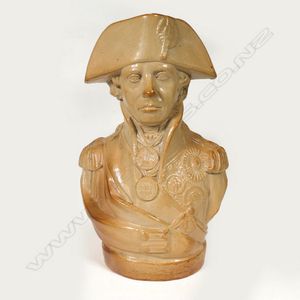Rare Antique Doulton & Watts Admiral Lord Nelson Jug
A rare, antique Doulton & Watts large character jug of Admiral Lord Nelson, c.1821-30, modelled to the waist (one of three variations: one a head and shoulders; this one showing full awards and decorations, with empty sleeve, and a flask), this was the first character jug made by Doulton. Light brown salt glaze. Small firing flaws inside bicorn hat.
You must be a subscriber, and be logged in to view price and dealer details.
Subscribe Now to view actual auction price for this item
When you subscribe, you have the option of setting the currency in which to display prices to $Au, $US, $NZ or Stg.
This item has been sold, and the description, image and price are for reference purposes only.
- Firing Crack - A firing crack is a crack in a porcelain or stoneware item that occurs whilst the item is in the kiln.They are usually caused by faulty design, where one part is thicker than the surrounding area, and being thicker it cools more slowly, setting up a stress with the surrounding area. Firing cracks are not often seen on modern mass produced porcelain, as the damaged items are discarded during prooduction. However they are seen in earlier items and artisan-produced objects.
- Salt Glazed - Salt glazing involves throwing salt into the kiln when it is at its highest temperature, usually around 2,300 to 2,400 degrees Fahrenheit (1,260 to 1,320 degrees Celsius). The salt vaporizes and forms a glaze on the surface of the pottery, creating a range of effects depending on how the salt is applied and the firing conditions. This glazing method was first developed in Germany in the 15th century and quickly became popular throughout Europe and North America. It was particularly popular for making stoneware pottery, such as jugs, crocks, and other utilitarian objects.
Salt glazes can produce a range of colors, including gray, brown, blue, and even pink or purple in some cases. The texture of the glaze is typically rough and pebbled, with a matte or satin finish. The process of salt glazing can be unpredictable, with variations in temperature and salt application leading to subtle variations in the finished product.
Salt glazing is still used by potters and ceramic artists although it is less common than it was in the past.
This item has been included into following indexes:
